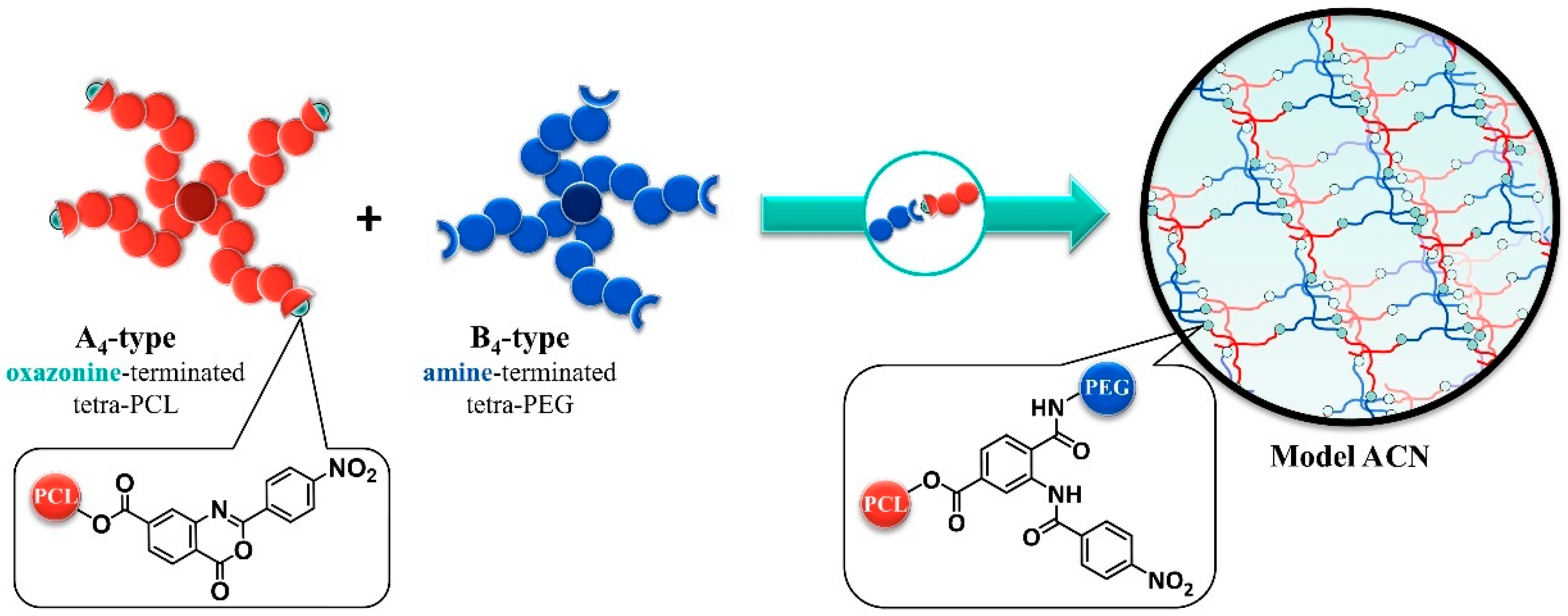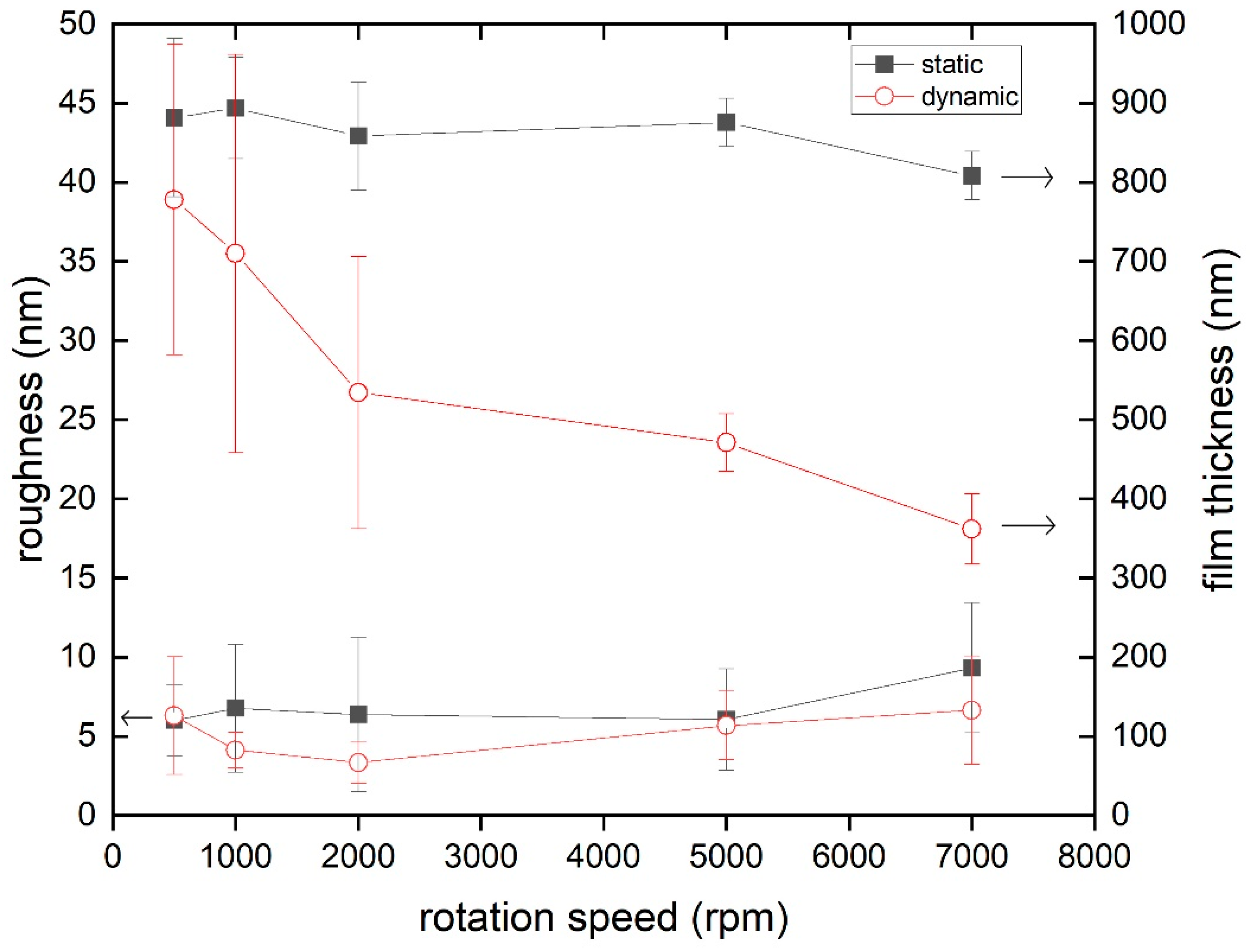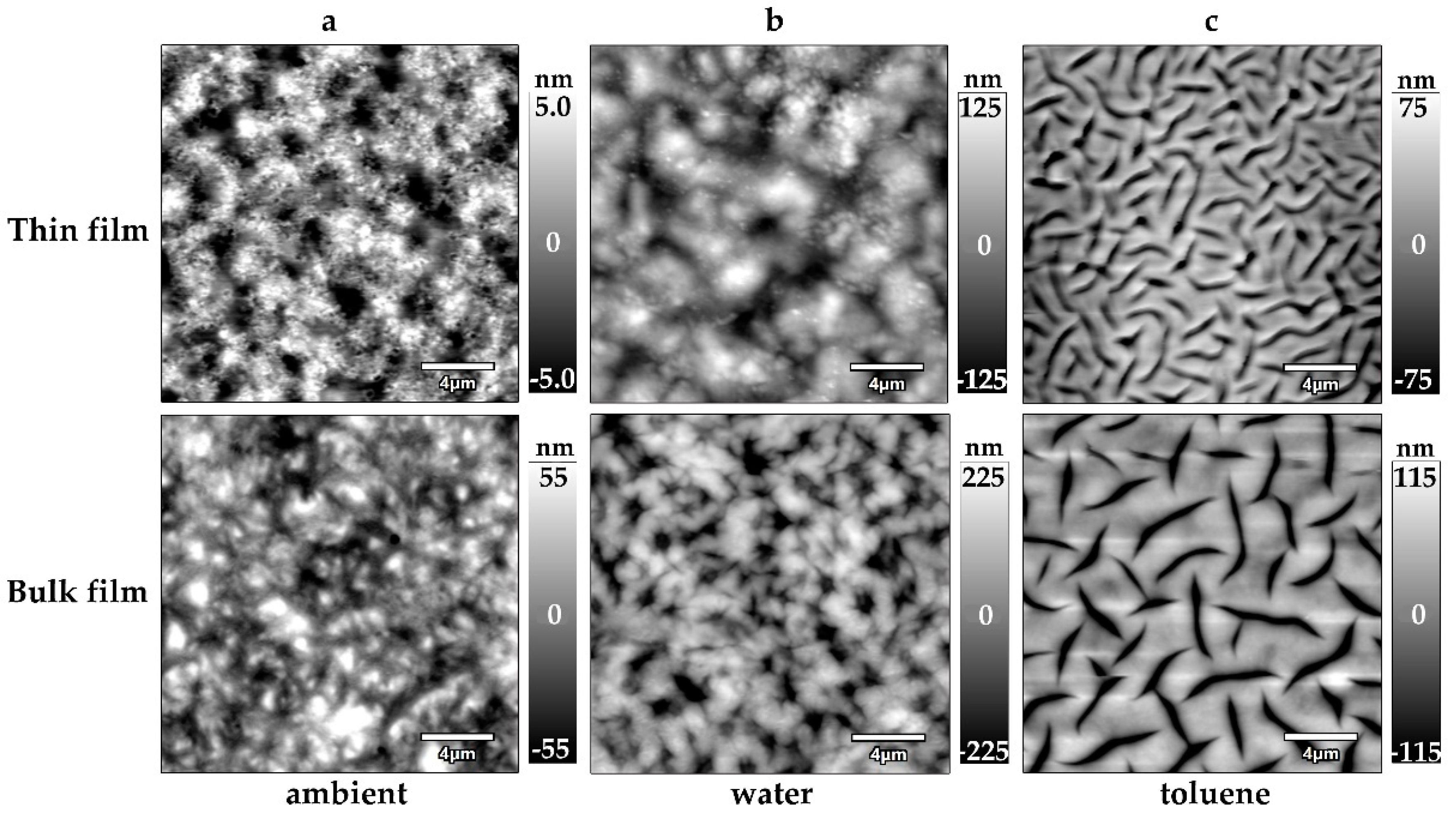Amphiphilic Polymer Conetwork Gel Films Based on Tetra-Poly(ethylene Glycol) and Tetra-Poly(ε-Caprolactone)
Abstract
1. Introduction
2. Materials and Methods
2.1. Materials
2.2. Synthesis of Amine-Terminated Tetra-PEG (Tetra-PEG-NH2) and 2-(4-Nitrophenyl) Benzoxazinone-Terminated Tetra-PCL (Tetra-PCL-Ox)
2.3. Preparation of Substrates
2.3.1. Silicon or Glass Substrates
2.3.2. Amino-Functionalized Substrates
2.4. Preparation of ACN Gel Films
2.4.1. Preparation of Thin ACN Gel Films
2.4.2. Preparation of Bulk ACN Gel Films
2.5. AFM
3. Results
3.1. Challenges of ACN Gel Film Preparation
3.2. Surface Topography and Thickness of ACN Gel Films in Ambient Conditions
3.3. Surface Topography and Thickness of ACN Gel Films against Solvents
3.4. Mechanical Properties of ACN Gel Films
4. Discussion
4.1. Preparation of ACN Gel Films
4.2. AFM Topography of ACN Gel Surfaces
4.3. Nano-Mechanical Properties at ACN Gel Surfaces
5. Conclusions
Supplementary Materials
Author Contributions
Funding
Data Availability Statement
Acknowledgments
Conflicts of Interest
References
- Erdodi, G.; Kennedy, J.P. Amphiphilic Conetworks: Definition, Synthesis, Applications. Prog. Polym. Sci. 2006, 31, 1–18. [Google Scholar] [CrossRef]
- Kali, G.; Georgiou, T.K.; Iván, B.; Patrickios, C.S.; Loizou, E.; Thomann, Y.; Tiller, J.C. Synthesis and Characterization of Anionic Amphiphilic Model Conetworks Based on Methacrylic Acid and Methyl Methacrylate: Effects of Composition and Architecture. Macromolecules 2007, 40, 2192–2200. [Google Scholar] [CrossRef]
- Apostolides, D.E.; Patrickios, C.S.; Sakai, T.; Guerre, M.; Lopez, G.; Améduri, B.; Ladmiral, V.; Simon, M.; Gradzielski, M.; Clemens, D.; et al. Near-Model Amphiphilic Polymer Conetworks Based on Four-Arm Stars of Poly(Vinylidene Fluoride) and Poly(Ethylene Glycol): Synthesis and Characterization. Macromolecules 2018, 51, 2476–2488. [Google Scholar] [CrossRef]
- Eschbach, F.O.; Huang, S.J. Hydrophilic—Hydrophobic Interpenetrating Polymer Networks and Semi-Interpenetrating Polymer Networks. Adv. Chem. 1994, 239, 205–219. [Google Scholar] [CrossRef]
- Nicolson, P.C.; Urgen Vogt, J.U. Soft contact lens polymers: An evolution. Biomaterials 2001, 22, 3273–3283. [Google Scholar] [CrossRef]
- Friends, G.D.; Kunzler, J.F.; Ozark, R.M. Recent Advances in the Design of Polymers for Contact Lenses. Macromol. Symp. 1995, 98, 619–631. [Google Scholar] [CrossRef]
- Haigh, R.; Rimmer, S.; Fullwood, N.J. Synthesis and Properties of Amphiphilic Networks. 1: The Effect of Hydration and Polymer Composition on the Adhesion of Immunoglobulin-G to Poly(laurylmethacrylate-stat-glycerolmonomethacrylate-stat-Ethylene-glycol-dimethacrylate) Networks. Biomaterials 2000, 21, 735–739. [Google Scholar] [CrossRef]
- Haigh, R.; Fullwood, N.; Rimmer, S. Synthesis and Properties of Amphiphilic Networks 2: A Differential Scanning Calorimetric Study of Poly(dodecyl methacrylate-Stat-2,3 propandiol-1-methacrylate-stat-ethandiol dimethacrylate) Networks and Adhesion and Spreading of Dermal Fibroblasts on These Materials. Biomaterials 2002, 23, 3509–3516. [Google Scholar] [CrossRef]
- Tiller, J.C.; Sprich, C.; Hartmann, L. Amphiphilic Conetworks as Regenerative Controlled Releasing Antimicrobial Coatings. J. Control. Release 2005, 103, 355–367. [Google Scholar] [CrossRef]
- Ulrich, S.; Osypova, A.; Panzarasa, G.; Rossi, R.M.; Bruns, N.; Boesel, L.F. Pyranine-Modified Amphiphilic Polymer Conetworks as Fluorescent Ratiometric PH Sensors. Macromol. Rapid Commun. 2019, 40, e1900360. [Google Scholar] [CrossRef]
- Huang, C.S.; Jakubowski, K.; Ulrich, S.; Yakunin, S.; Clerc, M.; Toncelli, C.; Rossi, R.M.; Kovalenko, M.V.; Boesel, L.F. Nano-Domains Assisted Energy Transfer in Amphiphilic Polymer Conetworks for Wearable Luminescent Solar Concentrators. Nano Energy 2020, 76, 105039. [Google Scholar] [CrossRef]
- Hild, G. Model networks based on ‘endlinking’ processes: Synthesis, structure and properties. Prog. Polym. Sci. 1998, 23, 1019–1149. [Google Scholar] [CrossRef]
- Lang, M. Cyclic Structures in Polymer Model Networks. Macromol. Symp. 2019, 385, 4886–4895. [Google Scholar] [CrossRef]
- Sakai, T.; Matsunaga, T.; Yamamoto, Y.; Ito, C.; Yoshida, R.; Suzuki, S.; Sasaki, N.; Shibayama, M.; Chung, U.I. Design and Fabrication of a High-Strength Hydrogel with Ideally Homogeneous Network Structure from Tetrahedron-like Macromonomers. Macromolecules 2008, 41, 5379–5384. [Google Scholar] [CrossRef]
- Weber, M.; Stadler, R. Hydrophilic-hydrophobic two-component polymer networks: 1. Synthesis of reactive poly(ethylene oxide) telechelics. Polymer 1988, 29, 1064–1070. [Google Scholar] [CrossRef]
- Erdödi, G.; Iván, B. Novel Amphiphilic Conetworks Composed of Telechelic Poly(Ethylene Oxide) and Three-Arm Star Polyisobutylene. Chem. Mater. 2004, 16, 959–962. [Google Scholar] [CrossRef]
- Matsunaga, T.; Sakai, T.; Akagi, Y.; Chung, U.I.; Shibayama, M. SANS and SLS Studies on Tetra-Arm PEG Gels in as-Prepared and Swollen States. Macromolecules 2009, 42, 6245–6252. [Google Scholar] [CrossRef]
- Matsunaga, T.; Sakai, T.; Akagi, Y.; Chung, U.I.; Shibayama, M. Structure Characterization of Tetra-PEG Gel by Small-Angle Neutron Scattering. Macromolecules 2009, 42, 1344–1351. [Google Scholar] [CrossRef]
- Hiroi, T.; Ohl, M.; Sakai, T.; Shibayama, M. Multiscale Dynamics of Inhomogeneity-Free Polymer Gels. Macromolecules 2014, 47, 763–770. [Google Scholar] [CrossRef]
- Lange, F.; Schwenke, K.; Kurakazu, M.; Akagi, Y.; Chung, U.I.; Lang, M.; Sommer, J.U.; Sakai, T.; Saalwächter, K. Connectivity and Structural Defects in Model Hydrogels: A Combined Proton NMR and Monte Carlo Simulation Study. Macromolecules 2011, 44, 9666–9674. [Google Scholar] [CrossRef]
- Schwenke, K.; Lang, M.; Sommer, J.U. On the Structure of Star-Polymer Networks. Macromolecules 2011, 44, 9464–9472. [Google Scholar] [CrossRef]
- Lang, M. On the Elasticity of Polymer Model Networks Containing Finite Loops. Macromolecules 2019, 52, 6266–6273. [Google Scholar] [CrossRef]
- Patrickios, C.S. (Ed.) Amphiphilic Polymer Co-Networks: Synthesis, Properties, Modelling and Applications. In RSC Polymer Chemistry Series; Royal Society of Chemistry: London, UK, 2020; No. 33. [Google Scholar]
- Bunk, C.; Löser, L.; Fribiczer, N.; Komber, H.; Jakisch, L.; Scholz, R.; Seiffert, S.; Voit, B.; Saalwächter, K.; Lang, M.; et al. Amphiphilic Model Networks Based on PEG and PCL Tetra-Arm Star Polymers with Complementary Reactivity. Macromolecules 2022. to be published. [Google Scholar] [CrossRef]
- Müller-Buschbaum, P.; Maurer, E.; Bauer, E.; Cubitt, R. Surface versus Confinement Induced Morphology Transition in Triblock Copolymer Films: A Grazing Incidence Small Angle Neutron Scattering Investigation. Langmuir 2006, 22, 9295–9303. [Google Scholar] [CrossRef] [PubMed]
- Müller-Buschbaum, P.; Bauer, E.; Wunnicke, O.; Stamm, M. The Control of Thin Film Morphology by the Interplay of Dewetting, Phase Separation and Microphase Separation. J. Phys. Condens. Matter 2005, 17, S363–S386. [Google Scholar] [CrossRef]
- Iván, B.; Haraszti, M.; Erdodi, G.; Scherble, J.; Thomann, R.; Mülhaupt, R. New Nanophase Separated Intelligent Amphiphilic Conetworks and Gels. Macromol. Symp. 2005, 227, 265–274. [Google Scholar] [CrossRef]
- Fodor, C.; Kali, G.; Thomann, R.; Thomann, Y.; Iván, B.; Mülhaupt, R. Nanophasic Morphologies as a Function of the Composition and Molecular Weight of the Macromolecular Cross-Linker in Poly(: N -Vinylimidazole)- l -Poly(Tetrahydrofuran) Amphiphilic Conetworks: Bicontinuous Domain Structure in Broad Composition Ranges. RSC Adv. 2017, 7, 6827–6834. [Google Scholar] [CrossRef]
- Berezkin, A.V.; Jung, F.; Posselt, D.; Smilgies, D.M.; Papadakis, C.M. In Situ Tracking of Composition and Morphology of a Diblock Copolymer Film with GISAXS during Exchange of Solvent Vapors at Elevated Temperatures. Adv. Funct. Mater. 2018, 28, 1706226. [Google Scholar] [CrossRef]
- Guzman, G.; Nugay, T.; Kennedy, J.P.; Cakmak, M. Real-Time Monitoring of Chemical and Topological Rearrangements in Solidifying Amphiphilic Polymer Co-Networks: Understanding Surface Demixing. Langmuir 2016, 32, 3445–3451. [Google Scholar] [CrossRef]
- Guzman, G.; Nugay, T.; Nugay, I.; Nugay, N.; Kennedy, J.; Cakmak, M. High Strength Bimodal Amphiphilic Conetworks for Immunoisolation Membranes: Synthesis, Characterization, and Properties. Macromolecules 2015, 48, 6251–6262. [Google Scholar] [CrossRef]
- Kamata, H.; Chung, U.; Shibayama, M.; Sakai, T. Anomalous Volume Phase Transition in a Polymer Gel with Alternative Hydrophilic-Amphiphilic Sequence. Soft Matter 2012, 8, 6876–6879. [Google Scholar] [CrossRef]
- Bruns, N.; Scherble, J.; Hartmann, L.; Thomann, R.; Iván, B.; Mülhaupt, R.; Tiller, J.C. Nanophase Separated Amphiphilic Conetwork Coatings and Membranes. Macromolecules 2005, 38, 2431–2438. [Google Scholar] [CrossRef]
- Decher, G. Fuzzy Nanoassemblies: Toward Layered Polymeric Multicomposites. Science 1997, 277, 1232–1237. [Google Scholar] [CrossRef]
- Decher, G.; Hong, J.D.; Schmitt, J. Buildup of ultrathin multilayer films by a self-assembly process: III. Consecutively alternating adsorption of anionic and cationic polyelectrolytes on charged surfaces. Thin Solid Film. 1992, 210–211, 831–835. [Google Scholar] [CrossRef]
- Klitzing, R.V. Internal Structure of Polyelectrolyte Multilayer Assemblies. Phys. Chem. Chem. Phys. 2006, 8, 5012–5033. [Google Scholar] [CrossRef]
- Micciulla, S.; Sánchez, P.A.; Smiatek, J.; Qiao, B.; Sega, M.; Laschewsky, A.; Holm, C.; von Klitzing, R. Layer-by-Layer Formation of Oligoelectrolyte Multilayers: A Combined Experimental and Computational Study. Soft Mater. 2014, 12, S14–S21. [Google Scholar] [CrossRef][Green Version]
- Xia, J.; Gaynor, S.G.; Matyjaszewski, K. Controlled/“Living” Radical Polymerization. Atom Transfer Radical Polymerization of Acrylates at Ambient Temperature. Macromolecules 1998, 31, 5958–5959. [Google Scholar] [CrossRef]
- Burmistrova, A.; von Klitzing, R. Control of Number Density and Swelling/Shrinking Behavior of P(NIPAM-AAc) Particles at Solid Surfaces. J. Mater. Chem. 2010, 20, 3502–3507. [Google Scholar] [CrossRef]
- Burmistrova, A.; Richter, M.; Uzum, C.; Klitzing, R. Effect of Cross-Linker Density of P(NIPAM-Co-AAc) Microgels at Solid Surfaces on the Swelling/Shrinking Behaviour and the Young’s Modulus. Colloid Polym. Sci. 2011, 289, 613–624. [Google Scholar] [CrossRef]
- Eickelmann, S.; Riegler, H. Rupture of Ultrathin Solution Films on Planar Solid Substrates Induced by Solute Crystallization. J. Colloid Interface Sci. 2018, 528, 63–69. [Google Scholar] [CrossRef]
- Karpitschka, S.; Weber, C.M.; Riegler, H. Spin Casting of Dilute Solutions: Vertical Composition Profile during Hydrodynamic-Evaporative Film Thinning. Chem. Eng. Sci. 2015, 129, 243–248. [Google Scholar] [CrossRef]
- Danglad-Flores, J.; Eickelmann, S.; Riegler, H. Deposition of Polymer Films by Spin Casting: A Quantitative Analysis. Chem. Eng. Sci. 2018, 179, 257–264. [Google Scholar] [CrossRef]
- Butt, H.J.; Cappella, B.; Kappl, M. Force Measurements with the Atomic Force Microscope: Technique, Interpretation and Applications. Surf. Sci. Rep. 2005, 59, 1–152. [Google Scholar] [CrossRef]
- Dimitriadis, E.K.; Horkay, F.; Maresca, J.; Kachar, B.; Chadwick, R.S. Determination of Elastic Moduli of Thin Layers of Soft Material Using the Atomic Force Microscope. Biophys. J. 2002, 82, 2798–2810. [Google Scholar] [CrossRef]
- Oommen, B.; van Vliet, K.J. Effects of Nanoscale Thickness and Elastic Nonlinearity on Measured Mechanical Properties of Polymeric Films. Thin Solid Film. 2006, 513, 235–242. [Google Scholar] [CrossRef]
- Clifford, C.A.; Seah, M.P. Quantification Issues in the Identification of Nanoscale Regions of Homopolymers Using Modulus Measurement via AFM Nanoindentation. Appl. Surf. Sci. 2005, 252, 1915–1933. [Google Scholar] [CrossRef]
- Burmistrova, A.; Richter, M.; Eisele, M.; Üzüm, C.; von Klitzing, R. The Effect of Co-Monomer Content on the Swelling/Shrinking and Mechanical Behaviour of Individually Adsorbed PNIPAM Microgel Particles. Polymers 2011, 3, 1575–1590. [Google Scholar] [CrossRef]
- Di Lorenzo, F.; Hellwig, J.; von Klitzing, R.; Seiffert, S. Macroscopic and Microscopic Elasticity of Heterogeneous Polymer Gels. ACS Macro Lett. 2015, 4, 698–703. [Google Scholar] [CrossRef]
- Howarter, J.A.; Youngblood, J.P. Optimization of Silica Silanization by 3-Aminopropyltriethoxysilane. Langmuir 2006, 22, 11142–11147. [Google Scholar] [CrossRef]
- Xiang, S.; Xing, G.; Xue, W.; Lu, C.; Lin, J.M. Comparison of Two Different Deposition Methods of 3- Aminopropyltriethoxysilane on Glass Slides and Their Application in the ThinPrep Cytologic Test. Analyst 2012, 137, 1669–1673. [Google Scholar] [CrossRef]
- Ueber Die Berührung Fester Elastischer Körper. J. Für Die Reine Und Angew. Math. (Crelles J.) 1882, 1882, 156–171. [CrossRef]
- Nicolella, P.; Koziol, M.F.; Löser, L.; Saalwächter, K.; Ahmadi, M.; Seiffert, S. Defect-Controlled Softness, Diffusive Permeability, and Mesh-Topology of Metallo-Supramolecular Hydrogels. Soft Matter 2022, 18, 1071–1081. [Google Scholar] [CrossRef]
- Ahmadi, M.; Löser, L.; Fischer, K.; Saalwächter, K.; Seiffert, S. Connectivity Defects and Collective Assemblies in Model Metallo-Supramolecular Dual-Network Hydrogels. Macromol. Chem. Phys. 2020, 221, 1900400. [Google Scholar] [CrossRef]
- Lang, M.; Müller, T. Analysis of the Gel Point of Polymer Model Networks by Computer Simulations. Macromolecules 2020, 53, 498–512. [Google Scholar] [CrossRef]
- Mouhamad, Y.; Mokarian-Tabari, P.; Clarke, N.; Jones, R.A.L.; Geoghegan, M. Dynamics of Polymer Film Formation during Spin Coating. J. Appl. Phys. 2014, 116, 123513. [Google Scholar] [CrossRef]





| Rotation Speed (rpm) | Film Thickness (nm) Static Dynamic | Film Roughness (nm) Static Dynamic | ||
|---|---|---|---|---|
| 500 | 900 ± 100 | 800 ± 200 | 6 ± 2 | 6 ± 4 |
| 1000 | 890 ± 60 | 700 ± 300 | 7 ± 4 | 4 ± 1 |
| 2000 | 900 ± 100 | 500 ± 200 | 6 ± 5 | 3 ± 1 |
| 5000 | 880 ± 30 | 470 ± 40 | 6 ± 3 | 6 ± 2 |
| 7000 | 810 ± 30 | 360 ± 40 | 9 ± 4 | 7 ± 3 |
| Sample | Film Roughness (nm) Ambient Conditions | Film Roughness (nm) Water | Film Roughness (nm) Toluene |
|---|---|---|---|
| Thin film | 7 ± 4 | 35 ± 21 | 35 ± 17 |
| Bulk film | 17 ± 5 | 76 ± 27 | 66 ± 27 |
| Sample | Ewater (kPa) | Etoluene (kPa) |
|---|---|---|
| Thin film | 2800 ± 200 | 400 ± 100 |
| Bulk film | 290 ± 80 | 93 ± 6 |
Publisher’s Note: MDPI stays neutral with regard to jurisdictional claims in published maps and institutional affiliations. |
© 2022 by the authors. Licensee MDPI, Basel, Switzerland. This article is an open access article distributed under the terms and conditions of the Creative Commons Attribution (CC BY) license (https://creativecommons.org/licenses/by/4.0/).
Share and Cite
Hagmann, K.; Bunk, C.; Böhme, F.; von Klitzing, R. Amphiphilic Polymer Conetwork Gel Films Based on Tetra-Poly(ethylene Glycol) and Tetra-Poly(ε-Caprolactone). Polymers 2022, 14, 2555. https://doi.org/10.3390/polym14132555
Hagmann K, Bunk C, Böhme F, von Klitzing R. Amphiphilic Polymer Conetwork Gel Films Based on Tetra-Poly(ethylene Glycol) and Tetra-Poly(ε-Caprolactone). Polymers. 2022; 14(13):2555. https://doi.org/10.3390/polym14132555
Chicago/Turabian StyleHagmann, Kevin, Carolin Bunk, Frank Böhme, and Regine von Klitzing. 2022. "Amphiphilic Polymer Conetwork Gel Films Based on Tetra-Poly(ethylene Glycol) and Tetra-Poly(ε-Caprolactone)" Polymers 14, no. 13: 2555. https://doi.org/10.3390/polym14132555
APA StyleHagmann, K., Bunk, C., Böhme, F., & von Klitzing, R. (2022). Amphiphilic Polymer Conetwork Gel Films Based on Tetra-Poly(ethylene Glycol) and Tetra-Poly(ε-Caprolactone). Polymers, 14(13), 2555. https://doi.org/10.3390/polym14132555







